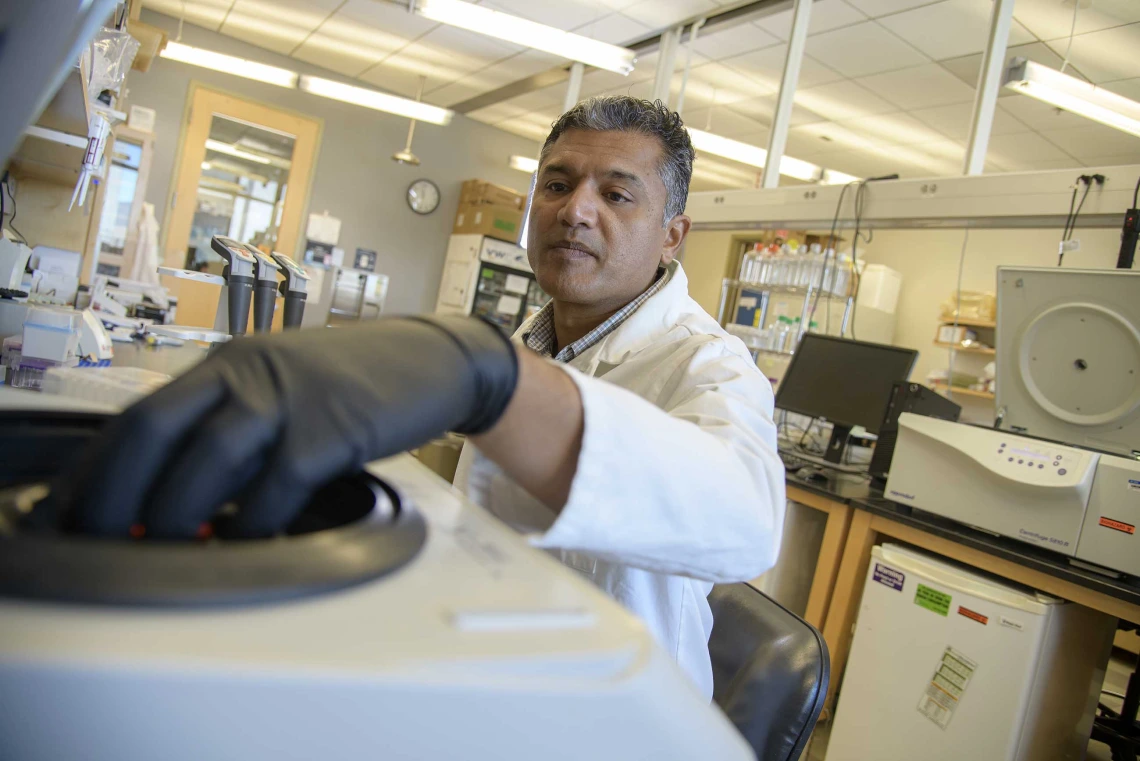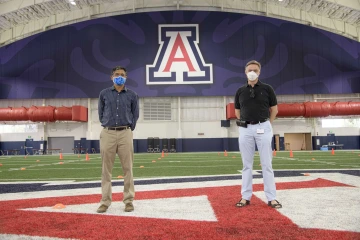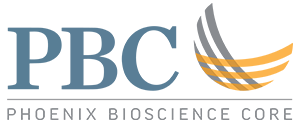Dr. Deepta Bhattacharya is shepherding a new era in immunology research as the inaugural executive director of the U of A Health Sciences Center for Advanced Molecular and Immunological Therapies.

Deepta Bhattacharya, PhD, remembers the mouse that humbled him. An ordinary mouse, in most respects, save a single missing gene. And Bhattacharya was going to figure out what that missing gene meant.
This was early in his days as a professor of pathology and immunology at Washington University in St. Louis. He was hot to trot, eager to impress. So he has this mouse with the missing gene, and immediately he can see the differences between it and a normally functioning mouse.
“All these differences that no one had ever reported before,” he said — differences pertaining to immune function and inflammation; differences that had real potential for application down-stream. “It’s like, ‘Yes, jackpot,’ right?”
But the further Bhattacharya and his colleagues got into their research, the less apparent the results became.

“It turned out there was another mutation in the mouse no one knew about,” he said. “And it turned out that all these things we were finding were because of the other gene, not the gene that we thought we were studying.”
And just like that, Bhattacharya’s daydream of the early-career scientist quickly and miraculously discovering insights previously unseen vanished.
“I think the longer you stay in this field the more humble you get, because you just accumulate all of these instances where you were sure that you were right, but then you do the experiment and it’s obvious you’re wrong,” he said. “I think that’s one of the things that makes it so much fun, because you can’t be sure, and it’s actually always — almost always — worth it to do that basic experiment.”
In a way, it was Bhattacharya’s uncertainty — or at least his comfort with the exploratory nature of it — that led him to immunology in the first place.
A Tucson native, he was born at the University of Arizona’s University Medical Center and raised on the east side. He moved to Indiana after his father took a job teaching math at Indiana University in Bloomington, where Bhattacharya later went to college.
Initially, he was going to be a chemistry major, but a quirk in the department’s language requirements — they would only accept French, German or Russian, and Bhattacharya had studied Spanish — led him to biochemistry instead.
“The requirements weren’t dramatically different, but obviously it required taking at least molecular biology, genetics, a couple of other things,” he said. “And I thought, ‘You know? I kind of like this better.’”
He ended up in a doctoral program at the University of California, Berkeley that allowed him to study aspects of both chemistry and biology. Immunology, the study of how our bodies use their own resources to defend against infection and disease, made an impression on him because it seemed like the path from basic science research in the lab to real-life treatment was relatively quick.
Even then, though, Bhattacharya noticed how the conventions of academia could be limiting, or at least foreshorten the horizon of how work could be applied.
“The term is a little overused, but it’s called the Valley of Death,” he said, explaining that academics aren’t evaluated on their ability to develop therapies, they’re evaluated on their ability to publish papers and procure grants. “A lot of great discoveries just die.”

It took the COVID-19 pandemic to show him what it might be like to work outside the bubble. He was back in Tucson as a professor in the Department of Immunobiology at the U of A College of Medicine – Tucson when he was suddenly drafted into helping the university come up with a response to a problem no one fully understood. Suddenly he was meeting with liaisons from state government and the Office of General Counsel — people scientists don’t ordinarily bump into.
“When you recognize that you’re not just trying to jockey for credit on paper, but that the things you’re doing have real implications for how safe people will be on campus, how the university is going to manage this crisis, it enforces a different mindset,” he said.
That promise of real impact is something Bhattacharya is hoping to bring to fruition in his new role as inaugural executive director of the U of A Health Sciences Center for Advanced Molecular and Immunological Therapies, or CAMI.
“I’ve been involved in some degree of drug development at this point and that almost always goes through startup companies,” he said.
Part of his vision with CAMI is to bridge the gap between research and business such that scientists have clearer paths — not to mention better incentives — for getting their work into the world, where it can make an impact on patients’ lives.
“That was one of the promises that we made to our state government, and I intend to fulfill it,” he said.
Bhattacharya often sounds like someone trying to reconcile the best qualities of divergent approaches the way one might make a stronger rope by braiding different materials: the experimental nature of academia with the bottom line of the entrepreneur, the process of research with the product of applied medicine.
“Leadership isn’t something I’d ever thought of,” he said. “If this were just, like, ‘OK, we want you to be the chair of an existing department.’ Not a chance.”
In CAMI, he sees the opportunity to do something new.
“A real experiment,” he said. “Hopefully it works, right? But that’s the fun part.”
In the meantime, he’s preparing as CAMI research is getting started in Phoenix and construction crews are getting ready to break ground on the center’s new building. What will it be like when CAMI is up and running? What changes await? He’ll probably have to dress a little differently, he says, tugging at the neck of his polo shirt. Whatever happens, he’s ready.
Originally Published by By Mike Powell, Arizona Alumni Association

